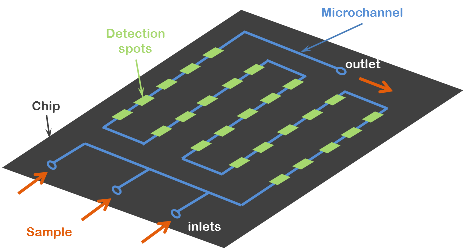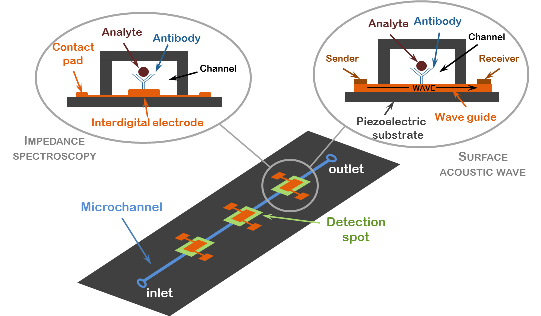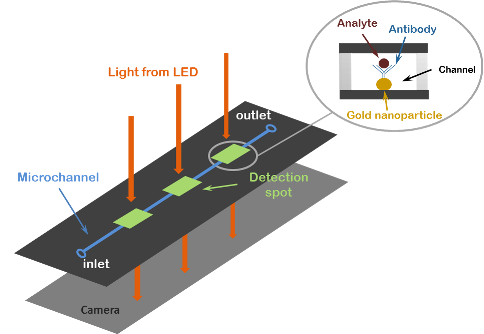Description
MICROBIOMED
Microtechnologies for Biomedicine Applications
Through the convergence of MEMS (Micro-Electro-Mechanical Systems) technology and life science, the MicroBioMed project aims at developing a network of expertise in the fields of micro and nanotechnologies applied to biomedicine.
Experts will develop a lab-on-chip demonstrator for the immunological detection of human diseases, in the framework of in-vitro diagnosis.
The developed solution will be biologically functional, medically relevant and economically viable for mass production.
MICROFLUIDIC LAB-ON-CHIP FOR EARLY DIAGNOSIS
One critical factor in diagnosis is the time of discovery. Recent works on microfluidic lab-on-chips have shown promising results for rapid, sensitive and low-cost diagnosis.

In such a device, a biologically active component (the receptor) is immobilized onto specific spots of the surface allowing the detection of target analytes within viscous liquid medium. The micro-channels allow the handling of very small biological samples.
Microfluidic systems are already used in analytical chemistry, molecular biology and micro-electronics but their application in clinical pathology is only emerging. The use of a biological sample implies changes regarding micro-structure, flow rate, detection method and surface functionalization.
In the project, two major detection strategies will be studied:
- Electrical detection : Impedance Spectroscopy and Surface Acoustic Wave
The first approach relies on impedance spectroscopy. Interdigital electrodes are integrated in the microfluidic channels and functionalized with antibody receptors using a “spot-by-spot” functionalization method. By applying alternative current to the electrodes, the electrical signals change with respect to the immobilization of receptor on the electrode area.
In the second approach, surface acoustic waves propagate through a piezoelectric substrate. The travel time of the wave from the sender to the receiver electrode depends on the mass which is attached to the substrate’s surface. The binding of an analyte to immobilized antibodies results in slower wave propagation through the substrates which can be measured.

- Optical detection : Local Surface Plasmon Resonance
Plasmonic gold nanoparticles are functionalized with antibody receptors, which can detect target analytes, and are immobilized onto the surface. Once the bio-reaction takes place, the gold nanoparticles will change their optical properties due to the local refractive index change, resulting in a wavelength shift in light absorption.

ONE APPLICATION: BREAST CANCER DIAGNOSIS
Current breast cancer diagnosis mainly relies on mammography and tissue biopsy. These methods often lead to a late diagnosis which endangers prognosis of survival.
In the field of “personalized medicine”, lots of ongoing research focus on cancer biomarkers in blood. Some markers are already used for the follow-up of cancer during the treatment phase. But no biomarker on the market is good enough to diagnose breast cancer.
In the project, new protein biomarkers will be identified and validated from cell lines, breast tissue and patient serum. The goal is to diagnose major types of breast cancers by using a combination of highly specific and highly sensitive markers for early detection.
Specific antibodies will then be generated against these markers and integrated as receptors into the analytical device.

Through the use of microfluidic lab-on-chip for cancer diagnosis, MicroBioMed stake is to position Euregio-Meuse-Rhine as a region of excellence in the field of microtechnology applied to biomedicine.
The lab-on-chip prototype will be used as a vehicle for dissemination. Research group and companies working in similar fields will be contacted during the project to promote the use of lab-on-chip for diagnosis. Different training modules will also be organized based on knowledge acquired during the project.
